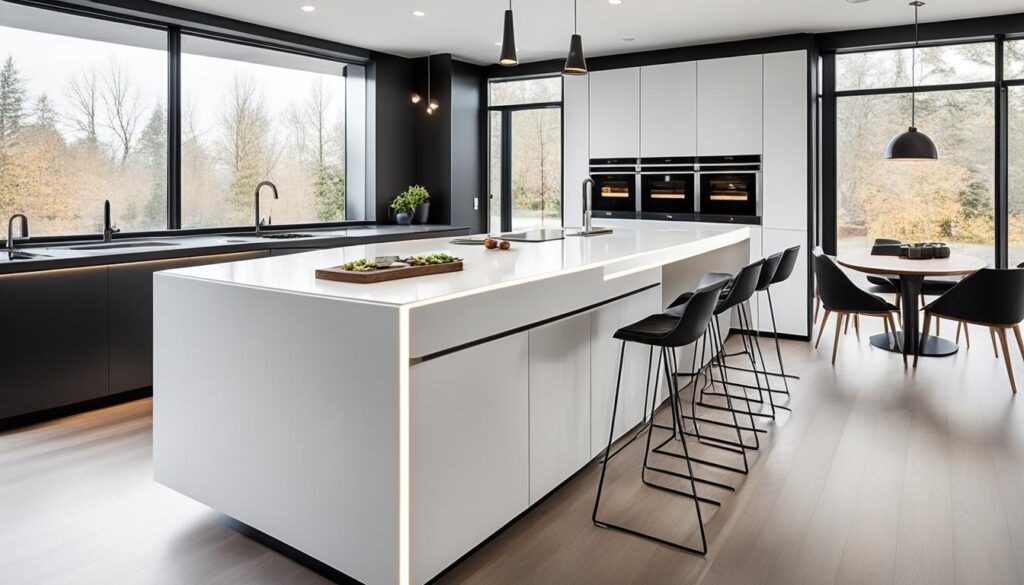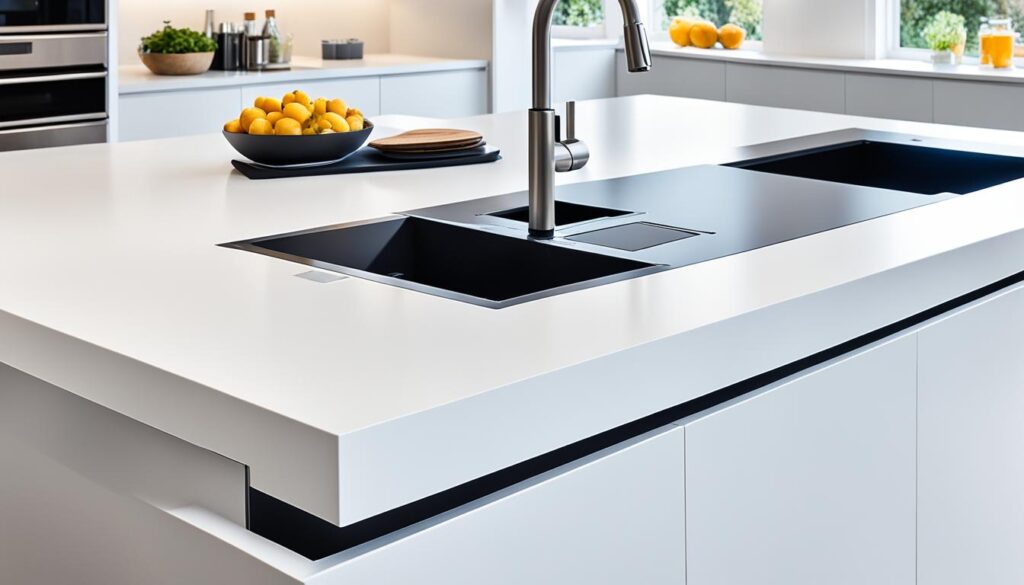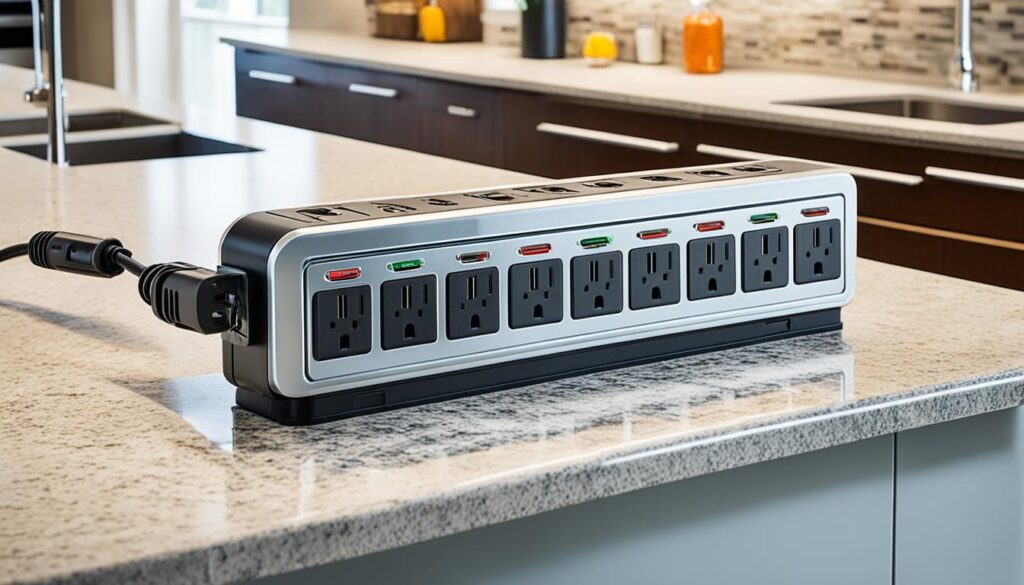In this ultimate guide, I will explore the different options for kitchen island power strips. Whether you are a homeowner, landlord, or property developer, there are various effective and stylish ways to add electrical outlets to your kitchen island. From hidden power strips to pop out and pop up sockets, we will discuss the advantages of choosing the right sockets for your kitchen island, including visual appeal and practicality.
Key Takeaways:
- There are different options for kitchen island sockets, including hidden power strips and pop out sockets.
- Choosing the right sockets can enhance the visual appeal and practicality of your kitchen island.
- Consider your specific needs and the overall aesthetic of your kitchen when planning socket placement and design.
- Ensure your kitchen power outlets comply with the regulations and safety requirements.
- By selecting the right power strip or outlets, you can enhance the functionality and style of your kitchen island.
Different Options for Kitchen Island Sockets
When it comes to kitchen island sockets, there are several options to choose from. These options provide both functionality and style, ensuring that your kitchen island meets your electrical needs while complementing your overall design. Let’s explore the different options:
Hidden Power Strip
A hidden power strip can be installed underneath an overhanging countertop, effectively concealing the outlets while providing easy access for powering appliances and using electrical items on the counter. This option allows you to keep your kitchen island clean and clutter-free, enhancing its visual appeal.
Pop Out Sockets
If you prefer a more discreet option, pop out sockets are a great choice. These sockets fit level against the vertical surface of the kitchen island cabinet and pop out when needed. This design ensures that the sockets remain hidden when not in use, maintaining the sleek look of your kitchen island.
Pop Up Socket Systems
For a truly innovative and space-saving solution, consider pop up socket systems. These systems allow a power strip to be installed underneath the countertop, with only a low-profile metal circle showing on the work surface. The sockets can easily be raised or lowered as needed, providing access to power while maintaining a clean and seamless appearance.

These different options for kitchen island sockets offer flexibility and functionality, allowing you to customize your kitchen island to suit your specific needs. Whether you choose a hidden power strip, pop out sockets, or pop up socket systems, you can enjoy a clutter-free workspace and a visually appealing kitchen island. With the right choice of sockets, your kitchen island can become the centerpiece of your kitchen, both in terms of style and practicality.
Advantages of Choosing the Right Sockets
When it comes to your kitchen island, selecting the right sockets can offer numerous benefits. Not only do they enhance the visual appeal of your kitchen, complementing your desired style and design, but they also provide practicality and convenience. Properly positioning the sockets ensures a clean and clutter-free countertop, minimizing cables and wires stretched across surfaces and improving electrical safety. With the right sockets, you can have the freedom to engage in other activities at your kitchen island, whether it’s sharing homework with your family or using appliances while cooking or baking.

Having the optimal countertop power strip or island power bar allows you to seamlessly integrate power outlets into your kitchen island without compromising aesthetics or functionality. By strategically placing the hidden power outlets, you can maintain the clean, sleek appearance of your countertop while still having easy access to power for your appliances and devices.
Additionally, these hidden power outlets for the island offer a sense of versatility, enabling you to rearrange your kitchen space as needed without the limitations of fixed wall outlets. This flexibility ensures that the design and layout of your kitchen island can easily adapt to your changing needs over time.
Investing in the right kitchen power bar or hidden power outlet for your island not only enhances the overall look and feel of your kitchen but also improves its efficiency and safety. With the convenience and practicality that these hidden power outlets provide, you can create a functional and visually appealing space for all your culinary activities.
Advantages of Choosing the Right Sockets
| Advantages | Description |
|---|---|
| Enhanced Visual Appeal | The right sockets can support the style and design you want to achieve, improving the overall aesthetic of your kitchen island. |
| Improved Safety | Proper placement of sockets minimizes cables and wires, reducing the risk of accidents and enhancing electrical safety in the kitchen. |
| Increased Flexibility | The right sockets offer versatility, allowing you to rearrange and adapt your kitchen island space without the limitations of fixed wall outlets. |
| Convenient Access to Power | Having the right sockets enables easy access to power for appliances and devices, making your kitchen island more functional and user-friendly. |
Ideas for Kitchen Socket Placement and Design
When planning the placement and design of your kitchen sockets, it is important to consider both functionality and aesthetics. The placement of your kitchen island electrical socket and the choice of an island power strip can greatly impact the overall look and convenience of your kitchen.
First, think about where you need plug sockets in your kitchen. You may need them on the worktop, the kitchen island, or the surrounding surface. Depending on your specific needs, you can strategically position your sockets for easy access while keeping the cables and wires hidden.
To seamlessly incorporate the sockets into your kitchen design, consider the style and theme you want to achieve. If you have a minimalist or modern kitchen, exposed sockets may be the best choice, adding a sleek and industrial touch. On the other hand, if you prefer a more traditional or rustic design, recessed sockets can be subtly integrated, providing a seamless appearance.
If you want to keep your kitchen island looking clutter-free, you can opt for hidden options like pop-up or under cabinet power strips. These innovative solutions allow you to have power outlets available only when needed. ()

| Socket Placement | Design |
|---|---|
| Near the sink | A recessed power strip is installed underneath the overhang of the kitchen island counter, providing easy access while keeping the area clutter-free. |
| In easily accessible areas | A pop-up socket system is incorporated into the kitchen island, allowing power outlets to be hidden when not in use. |
| On the worktop | An exposed power strip with a sleek design complements the minimalist style of the kitchen, providing easy access to power. |
By carefully considering the placement and design of your kitchen sockets, you can enhance both the functionality and aesthetics of your kitchen island. Make sure to choose the option that best suits your style and needs, while ensuring the safety and compliance with electrical regulations.
Kitchen Power Outlet Regulations and Safety
When it comes to installing power outlets in your kitchen, it’s essential to understand the relevant regulations and prioritize safety. Following the guidelines set forth by the National Electric Code ensures not only compliance but also the protection of your kitchen and loved ones. Let’s dive into the regulations for kitchen power outlets and how you can ensure a safe electrical setup in your kitchen.
Kitchen Countertop Outlets
According to the National Electric Code, kitchen countertops must have at least two power outlets rated for 20 amps. These outlets should be installed no more than 48 inches apart. These regulations ensure that you have an ample number of outlets for your kitchen appliances and gadgets, avoiding overloading any single outlet. Proper spacing between the outlets enhances convenience and functionality in your kitchen.
Kitchen Island Receptacles
When it comes to kitchen islands, the placement of power outlets is crucial. The National Electric Code specifies that kitchen island receptacles should be located within 24 inches from the center line of the island, either above or below the surface. This regulation ensures easy access to power while maintaining a visually appealing kitchen island. Whether you opt for a kitchen island power strip or a hidden power outlet, following this guideline is essential for safety and compliance.
GFCI Protection for Kitchen Outlets
An important safety requirement for kitchen power outlets is Ground Fault Circuit Interrupter (GFCI) protection. According to the National Electric Code, all receptacles within 6 feet of a sink must have GFCI protection. GFCI outlets are designed to protect against electric shock in wet or damp locations, making them essential for kitchen areas near water sources. Ensuring that your kitchen outlets have GFCI protection adds an extra layer of safety for you and your family.
By adhering to these regulations and safety requirements, you can create a secure electrical setup in your kitchen. Compliance not only ensures the safety of your loved ones but also provides peace of mind while using your kitchen appliances and gadgets.

Conclusion
In conclusion, finding the perfect power solution for your kitchen island is crucial for a functional and stylish space. Whether you prefer a hidden power outlet for your island, an island power strip, or a kitchen island electrical socket, it’s essential to choose an option that complements the design of your kitchen and meets your practical needs.
Consider the regulations and safety guidelines for kitchen power outlets, such as the National Electric Code in the United Kingdom, to ensure compliance and the safety of your kitchen. Adhering to these regulations will help you create a secure and efficient electrical system for your island.
By carefully selecting and strategically placing your power outlets, you can enhance the functionality of your kitchen island. Whether you opt for a discreet hidden power outlet, a convenient island power strip, or an easily accessible kitchen island electrical socket, you can enjoy a visually appealing and well-equipped space for all your culinary activities.

